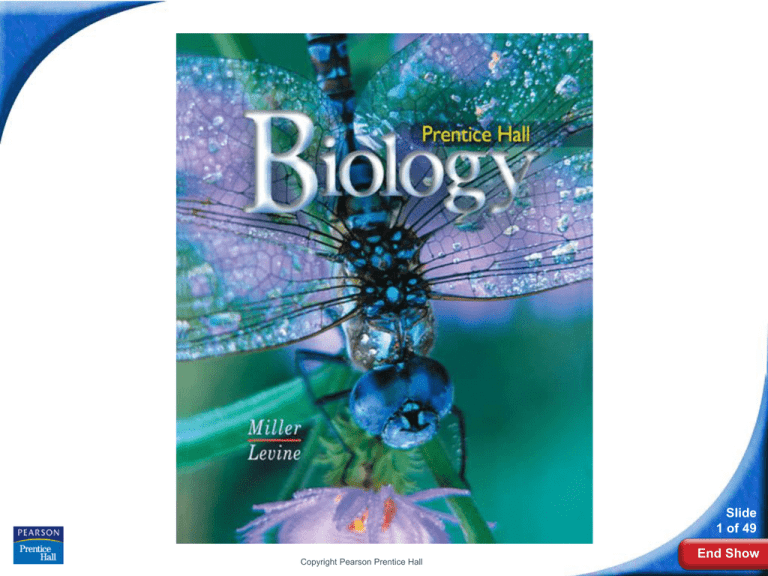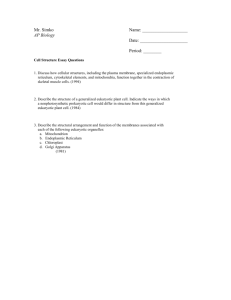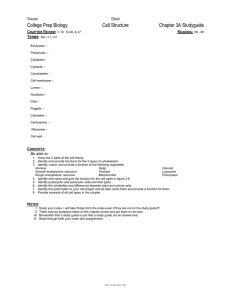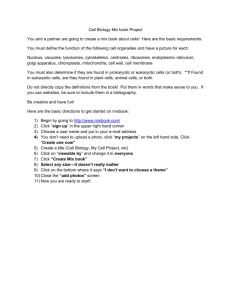
Biology
Biology
Slide
1 of 49
Copyright Pearson Prentice Hall
End Show
7-2 Eukaryotic Cell Structure
Slide
2 of 49
Copyright Pearson Prentice Hall
End Show
7-2 Eukaryotic Cell Structure
Eukaryotic Cell Structures
Eukaryotic Cell Structures
Structures within a eukaryotic cell that perform
important cellular functions are known as
organelles.
Cell biologists divide the eukaryotic cell into two
major parts: the nucleus and the cytoplasm.
The Cytoplasm is the portion of the cell outside
the nucleus.
Slide
3 of 49
Copyright Pearson Prentice Hall
End Show
7-2 Eukaryotic Cell Structure
Eukaryotic Cell Structures
Plant Cell
Nucleolus
Nucleus
Smooth
endoplasmic
reticulum
Nuclear envelope
Ribosome (free)
Rough endoplasmic
reticulum
Ribosome
(attached)
Golgi
apparatus
Cell wall
Cell membrane
Chloroplast
Mitochondrion
Vacuole
Slide
4 of 49
Copyright Pearson Prentice Hall
End Show
7-2 Eukaryotic Cell Structure
Eukaryotic Cell Structures
Animal Cell
Nucleolus
Smooth endoplasmic
reticulum
Nucleus
Ribosome (free)
Nuclear envelope
Cell membrane
Rough
endoplasmic
reticulum
Ribosome
(attached)
Centrioles
Golgi
apparatus
Mitochondrion
Slide
5 of 49
Copyright Pearson Prentice Hall
End Show
7-2 Eukaryotic Cell Structure
Nucleus
What is the function of the nucleus?
Slide
6 of 49
Copyright Pearson Prentice Hall
End Show
7-2 Eukaryotic Cell Structure
Nucleus
Nucleus
The nucleus is the control center of the cell.
The nucleus contains nearly all the cell's
DNA and with it the coded instructions
for making proteins and other important
molecules.
Slide
7 of 49
Copyright Pearson Prentice Hall
End Show
7-2 Eukaryotic Cell Structure
Nucleus
The Nucleus
Chromatin
Nuclear envelope
Nucleolus
Nuclear
pores
Slide
8 of 49
Copyright Pearson Prentice Hall
End Show
7-2 Eukaryotic Cell Structure
Ribosomes
What is the function of the ribosomes?
Slide
9 of 49
Copyright Pearson Prentice Hall
End Show
7-2 Eukaryotic Cell Structure
Ribosomes
Ribosomes
One of the most important jobs carried out in
the cell is making proteins.
Proteins are assembled on ribosomes.
Ribosomes are small particles of RNA and
protein found throughout the cytoplasm.
Slide
10 of 49
Copyright Pearson Prentice Hall
End Show
7-2 Eukaryotic Cell Structure
Endoplasmic Reticulum
What is the function of the endoplasmic
reticulum?
Slide
11 of 49
Copyright Pearson Prentice Hall
End Show
7-2 Eukaryotic Cell Structure
Endoplasmic Reticulum
There are two types of ER—rough and smooth.
Endoplasmic
Reticulum
Ribosomes
Slide
12 of 49
Copyright Pearson Prentice Hall
End Show
7-2 Eukaryotic Cell Structure
Golgi Apparatus
What is the function of the Golgi
apparatus?
Slide
13 of 49
Copyright Pearson Prentice Hall
End Show
7-2 Eukaryotic Cell Structure
Golgi Apparatus
The Golgi apparatus appears as a stack of closely
apposed membranes.
Slide
14 of 49
Copyright Pearson Prentice Hall
End Show
7-2 Eukaryotic Cell Structure
Golgi Apparatus
What is the function of lysosomes?
Slide
15 of 49
Copyright Pearson Prentice Hall
End Show
7-2 Eukaryotic Cell Structure
Vacuoles
What is the function of vacuoles?
Slide
16 of 49
Copyright Pearson Prentice Hall
End Show
7-2 Eukaryotic Cell Structure
Vacuoles
In many plant cells there
is a single, large central
vacuole filled with liquid.
Vacuole
Slide
17 of 49
Copyright Pearson Prentice Hall
End Show
7-2 Eukaryotic Cell Structure
Vacuoles are also found
in some unicellular
organisms and in some
animals.
Vacuoles
Contractile vacuole
The paramecium contains
a contractile vacuole
that pumps excess water
out of the cell.
Slide
18 of 49
Copyright Pearson Prentice Hall
End Show
7-2 Eukaryotic Cell Structure
Mitochondria and Chloroplasts
What is the function of the mitochondria?
Slide
19 of 49
Copyright Pearson Prentice Hall
End Show
7-2 Eukaryotic Cell Structure
Mitochondria and Chloroplasts
Mitochondria
Nearly all eukaryotic
cells contain
mitochondria.
Mitochondria convert
the chemical energy
stored in food into
compounds that are
more convenient for
the cell to use.
Mitochondrion
Slide
20 of 49
Copyright Pearson Prentice Hall
End Show
7-2 Eukaryotic Cell Structure
Mitochondria and Chloroplasts
What is the function of chloroplasts?
Slide
21 of 49
Copyright Pearson Prentice Hall
End Show
7-2 Eukaryotic Cell Structure
Chloroplasts
Mitochondria and Chloroplasts
Chloroplast
Plants and some other
organisms contain
chloroplasts.
Chloroplasts capture
energy from sunlight
and convert it into
chemical energy in a
process called
photosynthesis.
Slide
22 of 49
Copyright Pearson Prentice Hall
End Show
7-2 Eukaryotic Cell Structure
Cytoskeleton
What are the functions of the
cytoskeleton?
Slide
23 of 49
Copyright Pearson Prentice Hall
End Show
7-2 Eukaryotic Cell Structure
Cytoskeleton
The cytoskeleton is a network of protein
filaments that helps the cell to maintain
its shape. The cytoskeleton is also
involved in movement.
The cytoskeleton is made up of:
• microfilaments
• microtubules
Slide
24 of 49
Copyright Pearson Prentice Hall
End Show
7-2 Eukaryotic Cell Structure
Cytoskeleton
Cytoskeleton
Cell membrane
Endoplasmic
reticulum
Microtubule
Microfilament
Ribosomes
Mitochondrion
Copyright Pearson Prentice Hall
Slide
25 of 49
End Show
7-2 Eukaryotic Cell Structure
Cytoskeleton
Centrioles are located near the nucleus and help to
organize cell division.
Cell Organelle Interactive
Plant and Animal Model Interactive
Copyright Pearson Prentice Hall
Slide
26 of 49
End Show
7-2
Click to Launch:
Continue to:
- or -
Slide
27 of 49
End Show
Copyright Pearson Prentice Hall
7-2
In the nucleus of a cell, the DNA is usually visible
as
a. a dense region called the nucleolus.
b. the nuclear envelope.
c. granular material called chromatin.
d. condensed bodies called chloroplasts.
Slide
28 of 49
End Show
Copyright Pearson Prentice Hall
7-2
Two functions of vacuoles are storing materials
and helping to
a. break down organelles.
b. assemble proteins.
c. maintain homeostasis.
d. make new organelles.
Slide
29 of 49
End Show
Copyright Pearson Prentice Hall
7-2
Chloroplasts are found in the cells of
a. plants only.
b. plants and some other organisms.
c. all eukaryotes.
d. most prokaryotes.
Slide
30 of 49
End Show
Copyright Pearson Prentice Hall
7-2
Which of the following is NOT a function of the
Golgi apparatus?
a. synthesize proteins.
b. modify proteins.
c. sort proteins.
d. package proteins.
Slide
31 of 49
End Show
Copyright Pearson Prentice Hall
7-2
Which of the following is a function of the
cytoskeleton?
a. manufactures new cell organelles
b. assists in movement of some cells from one
place to another
c. releases energy in cells
d. modifies, sorts, and packages proteins
Slide
32 of 49
End Show
Copyright Pearson Prentice Hall
END OF SECTION






